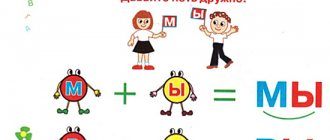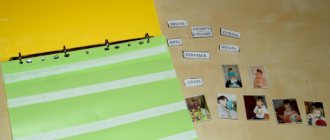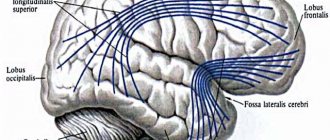Prevention of dysgraphia in preschoolers
When teaching preschoolers to read and write, parents should avoid common mistakes that can lead to reading and writing disorders in preschool children, dysgraphia and dyslexia.
What exercises should be done with a child to prevent the occurrence of dysgraphia?
Competent prevention of dysgraphia in preschoolers should be carried out in several areas:
- It is important before school and while learning to read to train the skills of sound analysis and synthesis. Failure to do so can lead to errors in writing and reading.
The child must master the concepts of “sound”, “letter”, “consonant”, “vowel”, “hard consonant”, “soft consonant”, “syllable”, “stress”, “word”, “sentence”.
The preschooler must find the differences between:
- letter and sound;
- vowel and consonant;
- word, syllable and sound;
- hard and soft consonants;
- voiced and voiceless consonants;
The future student should be able to divide a word into syllables, highlight a stressed syllable, and highlight the position of a given sound (or syllable) in a word.
Exercises to train sound analysis (phonemic analysis) should be done with all preschoolers in order to prevent the occurrence of dysgraphia due to disorders of language analysis and synthesis:
- Clap your hands when you hear the sound [O] and stamp your foot when you hear the sound [U].
- Arrange the pictures in two piles - on a blue and green field. Words that begin with soft sounds will be on the green field, those with hard sounds will be on the blue field.
- I will name the voiced sound, and you will name the paired unvoiced sound (B - P, D - T, etc.).
- I will call it hard, and you will call it paired soft (S - Sb, M - Mb, etc.).
- Voiced or voiceless? Put pictures whose names begin with a dull sound [P] in the house without a bell, and put pictures whose names begin with a voiced sound [B] in a house with a bell.
- Who has more? The one whose word card has the most syllables wins.
- Find words with the same first sound in the word.
- Find words with the same sound at the end of the word.
- If a child had problems with sound pronunciation and replaced one sound with another, it is necessary to correct the speech before you begin to teach the child to write and read. But it also happens that the sounds are corrected, but the child sometimes continues to confuse them! For example, before the baby used to pronounce the sound [S] instead of the sound [Ш], but the speech therapist made a hissing sound and everything seemed to be fine. But in some words, the child, as if out of habit, returns to the old pronunciation, and says “malys” instead of “baby”, or “kosmosh” instead of “kosmos”. It's funny, isn't it? Yes, but also dangerous! After all, this is how he will write.
Distinguishing sounds that the child mispronounced, confused and changed for each other should be well practiced in a variety of exercises to prevent dysgraphia:
- If you hear the sound [Ш], pick up its symbol (a picture symbolizing the sound, for example, a ball with air coming out of it), and if the sound [S] sounds, show its symbol (for example, a pump).
- Repeat the sounds after me, don’t confuse them: [Ш] [С] [С], [C] [С] [Ш], [Ш] [С] [Ш], etc.
- Raise the sound symbol [Ш] if you hear a word with this sound. If the word contains the sound [S], raise the sound symbol [S].
- Put pictures - words with the sounds [Ш] and [С] in different houses.
- When getting acquainted with letters, it is necessary to learn to call a letter by its sound analogue: [V] and not [VE] or [YY], [SH] and not [SHCHA] or [SHCHE], [L] and not [EL] or [EL] . Immediately teach your child to read each letter with only one sound that represents it . This will help teach reading. Otherwise, errors will appear in the letter associated with an incorrect, distorted sound image of the letter; the child will write instead of “vaza” - “veaza”, instead of “pike” - “schuka”, instead of “bow” - “lyuk”, because the child pronounces the name letters as 2 sounds. There will be confusion in the perception of letters and sounds of our speech.
If such a mistake was made by parents or a teacher (this also happens), perform exercises to prevent dysgraphia:
- Sound dictation. The adult names the letter (pronouncing them as one sound), the child writes.
- Visual dictation. An adult draws a letter on a board or piece of paper, the child writes it and pronounces it (only one sound denoting a letter): letter [Ш], letter [T], etc.
- Determine which letter is the first in the words and name it. An adult offers a set of 2-3 pictures, the names of which begin with the same sound. For example: fish, rudder, lynx - all words begin with the letter P (letter [P]).
- When learning to write (in block letters) before school, you need to do a lot of exercises to consolidate the correct image of the letter. It is necessary to teach the child not to confuse letters that have similar elements and not to turn them over, and to write each letter in the correct direction. The better a child remembers the image of a letter, the fewer mistakes he will make when writing.
Carry out exercises with your preschooler to prevent optical dysgraphia:
- Circle the letter;
- Blind a letter from plasticine, lay it out from counting sticks or rope;
- Complete the missing details;
- Cross out incorrectly written letters;
- Learn a poem about the letter.
- What letter will you get if you add details?
- What letter will you get if you remove the details?
- Draw a letter in the air.
- Compare 2 letters, how are they similar and how are they different?
Take the time to spend with your child before school. Teach your preschooler to read and write correctly. A large selection of manuals and games will help you make your classes interesting and rich. It is easier to prevent dysgraphia than to struggle with eliminating dysgraphia at school. And your efforts will be rewarded with good grades and success of your first grader.
Teacher-speech therapist Surgucheva S.N.
Dysgraphia – what is it?
Dysgraphia is a writing disorder that is not associated with ignorance of the rules of grammar. The disorder is manifested by persistent, typical errors:
- replacing letters with similar sounds: b-p, t-d;
- incorrect endings of words;
- continuous writing of prepositions;
- no indentation;
- "mirror" letter;
- illegible handwriting and a number of others.
Example
A child unfamiliar with the rules of grammar will write the word “sentence” as “sentence”, and a dysgraphic person will write “breathing”.
Mechanisms of occurrence
From the point of view of neuropsychology, the cause of dysgraphia is the immaturity of higher mental functions, which include:
- visual analysis and synthesis;
- spatial representation;
- differentiation of speech sounds;
- phonemic and syllabic analysis and synthesis;
- dividing sentences into words;
- attention;
- memory;
- emotional-volitional sphere.
Mastering written language requires the coordinated work of the whole brain. He must have time to process information coming from the organs of hearing, vision, and tactile sensations. This is a colossal load that every first grader faces. But over the course of the year his skills improve.
If at the end of the first school year there is no improvement, the child makes the same mistakes, is restless, distracted and lags far behind his peers, then he should be checked for dysgraphia. The violation does not go away on its own, but is successfully corrected by specialists.
Diagnostics
The examination for violations of written and spoken speech is carried out as completely as possible, including both psychological, speech therapy and medical diagnostic methods. First of all, specialists strive to identify the cause of the disorder. To do this you need:
- study the features of intrauterine development of a child, his first months and years of life;
- assess the general neurological, physical and mental health of the young patient;
- collect complete information about past injuries and illnesses, pathologies of close relatives;
- study the student’s lifestyle, his environment, and the emotional situation in the family.
The main task of diagnosis is the separation of disorders caused by real pathology and symptoms provoked by a basic lack of knowledge, which plays a decisive role in choosing a correction scheme.
The examination package may include:
- consultations with a neurologist, ophthalmologist, endocrinologist, child psychiatrist;
- examination by an audiologist and otolaryngologist;
- instrumental diagnostic techniques (electroencephalography, MRI, duplex scanning of the vessels of the brain and cervical spine).
Psychological and speech therapy assessment is aimed at:
- to study and analyze written works;
- to assess general speech development;
- to determine the level of development of the articulatory apparatus;
- to assess the volume of vocabulary;
- analysis of sound pronunciation, auditory perception and separation of phonemes, grammatical skills.
Additionally, specialists conduct a number of practical tests, consisting of copying printed and handwritten text, writing sentences after auditory listening. The child is also asked to describe the picture in writing, divide the word into syllables, highlight the structure of the sentence, etc.
Based on a complex of studies, speech pathologists and speech pathologists select the most optimal correction program depending on the nature of the errors, the degree of manifestation of the written disorder and other parameters of the disorders.
Formation of articulatory and acoustic dysgraphia
To eliminate factors that contribute to articulatory and acoustic types of dysgraphia, you need to follow these tips.
In the process of developing the differentiation of sound pairs by ear, the most important thing is that the child can emphasize the differences between the sounds in question. He must make sure that he hears two different sounds, not just one.
Since the child is not able to distinguish sounds by ear, hearing in this system becomes a very weak link. Therefore, you need to rely on something stronger - for example, vision. After all, any sound pair differs not only in how it sounds, but also in how the articulatory organs are located during the pronunciation of sounds.
Since these organs have different positions, this results in different sounds. Therefore, it is necessary to initially draw children’s attention to how the organs of articulation are positioned when pronouncing each sound.
The next task is to very clearly emphasize the difference that exists in the sound of different sounds. To do this, you can first identify these sounds with those that often sound in nature. The teacher should pronounce natural sounds for a long time and exaggeratedly.
You can also describe the differences verbally. For example, if a child does not distinguish between the sounds Zh and Z (Sh and S) by ear, then a sonorous letter can be identified with ringing, a buzzing letter with a buzzing sound, and a dull letter with a rustling or whistling sound. Sometimes the child is helped by funny phrases that demonstrate exactly how certain sounds sound.
Then you can play “bug and mosquito” with the children. The mouth needs to be covered with a screen so that the child cannot visually perceive what you say through your lips. The teacher buzzes or squeaks. And the child must determine which insect is “sounding” now.
The same applies to other sound pairs.
After the differences in the sounds of these pairs have been explained and demonstrated to the child many times, the remaining pairs will be much easier for him to assimilate, because the ear has already tuned in to the process of differentiation.
Then you need to move on to distinguishing speech sounds, which is more accessible and understandable for children.
But teaching children to differentiate by ear only sounds pronounced in isolation is not enough. It is imperative to teach the child to feel the different sounds that make up a word. This will be useful to him both in oral statements and in writing.
Then you need to conduct didactic games to develop in children the ability to accurately identify any mixed sounds in a verbal composition.
Formation of auditory function in children with OHP
In order for a child with ODD to successfully master writing skills, it is necessary to develop his auditory function. The child must be able to clearly differentiate sounds that are similar in sound, analyze and synthesize words, be well oriented in space, master the sound component of speech, have a good vocabulary, developed motor skills and be able to speak coherently.
When working with children who suffer from ODD, it is necessary to develop in them a whole range of linguistic means, to formulate their use in speech.
This work is aimed at the mental development of children, their memory and attention, intelligence and volitional emotional sphere. This means that it is necessary to form those qualities and functions without which it will not be possible to fully master speech behavior. We also need to help children move to the next level of speech and intelligence development - start writing correctly.
Therefore, it is better to carry out preventive measures to combat dysgraphia already in the preschool period. Without the work of speech therapists, this problem will not disappear on its own. Only competent correctional work will help to quickly overcome all the factors that lead to writing problems and a decrease in school performance.
The speech therapist must carry out the work consistently.
The first stage is preparatory in nature. It is necessary to prepare the child’s articulatory apparatus for the development of articulatory habits. It is necessary to develop in children the need for communication and the formation of a vocabulary. You also need to correct your voice and breathing.
How to find out if a child has disorders?
Diagnosis of dysgraphia is carried out on the basis of the conclusions of a speech therapist, neurologist, ophthalmologist, and otolaryngologist. The child is asked to write a short dictation, rewrite text from a book, describe a picture, or read. The specialist evaluates the nature of the errors and, based on age, determines or does not determine the disorder.
Before 8–9 years of age the diagnosis is not made. From 6 to 8 years old, a student only masters writing skills and learns the rules. However, the prerequisites for dysgraphia can be visible much earlier, even in preschool age. Timely prevention helps prevent future violations.
When is prevention needed?
Preventive measures will not be superfluous for any preschooler. Special games and tasks will help prepare your child for school and make it easier to master written language.
But prevention is especially important for the following groups of children:
- children with speech therapy problems;
- children with ADHD;
- children whose parents suffered from dysgraphia and dyslexia at school age.
At an early age, the following symptoms may indicate possible disturbances in the structure of written speech:
- in kindergarten it is difficult for a child to learn poems and songs;
- he has difficulty repeating and reproducing rhythms;
- his movements are poorly coordinated (clumsy, awkward);
- does not like to draw and does it poorly (the lines are broken, not closed, the shading extends far beyond the edges);
- the child experiences difficulty in assembling construction sets and sculpting three-dimensional figures from plasticine;
- confuses the sounds B and P, K and T, S and Z, pronounces words illegibly and incorrectly;
- unable to concentrate on completing tasks due to age.
Causes
Writing is a multi-level process in which several components are involved at once: visual, auditory, speech and motor systems. When interaction is disturbed, there is no coordination between systems, persistent disorders arise, characterized not only by a disorder of written, but also oral speech.
The causes of dysgraphia in primary schoolchildren and adolescents can be divided into two subgroups: organic and socio-psychological. Organic ones include:
- various brain lesions that occurred in the prenatal period or in the first months of life;
- infections suffered by the fetus during intrauterine development;
- bad habits of the mother during pregnancy (active smoking, alcoholic libations, use of illegal drugs);
- irrational or improper use of potent drugs by the mother during pregnancy;
- birth injuries resulting in mechanical damage to the brain, asphyxia;
- prematurity;
- previous infectious diseases affecting the central nervous system and brain (meningitis, encephalitis);
- severe somatic diseases with long-term treatment, resulting in nervous and physical exhaustion of the baby.
Experts point to the hereditary factor as a common cause of the development of dysgraphia in preschoolers and primary school students, as well as various diseases associated with damage to the central nervous, visual and auditory systems. Children who are prone to developing written disabilities also include children who have problems with fine motor skills.
The socio-psychological causes of dysgraphia include:
- communication within the family and in the child’s immediate environment in several languages;
- the child being left to himself, when parents and other close relatives are not involved in the general physical and mental development of the child, inattention to speech errors (pedagogical neglect);
- lack of verbal communication;
- premature or very late learning of literacy, reading, and writing skills;
- unstable psychological situation in the family (alcoholism and drug addiction of parents, frequent scandals between mom and dad, physical violence towards the child).
Speech therapists also consider one of the circumstances that can influence a child’s speech development to be the constant use of diminutive variants of words when talking to children, the deliberate softening of hard sounds, which is popularly called lisp.







